|
|
|
Sort Order |
|
|
|
Items / Page
|
|
|
|
|
|
|
| Srl | Item |
| 1 |
ID:
092832
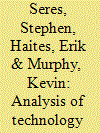

|
|
|
|
|
| Publication |
2009.
|
| Summary/Abstract |
The clean development mechanism (CDM) contributes to technology transfer by financing emission reduction projects using technologies not available in the host countries. This paper provides the most comprehensive analysis of technology transfer in the CDM to-date, covering 3296 registered and proposed projects. Roughly 36% of the projects accounting for 59% of the annual emission reductions claim to involve technology transfer. Technology transfer is more common for larger projects and projects with foreign participants. Technology transfer is very heterogeneous across project types and usually involves both knowledge and equipment. As the number of projects increases, technology transfer occurs beyond the individual projects. This is observed for several of the most common project types in China and Brazil with the result that the rate of technology transfer for new projects in those countries has fallen significantly.
|
|
|
|
|
|
|
|
|
|
|
|
|
|
|
|
| 2 |
ID:
117266
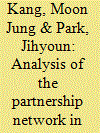

|
|
|
|
|
| Publication |
2013.
|
| Summary/Abstract |
The clean development mechanism (CDM) is a global collaborative action proposed at the Kyoto Protocol in response to climate change issues. The CDM contributes to cost-efficient reduction of greenhouse gas emissions in industrialized countries and promotes sustainable development in developing countries. Its fundamental framework is based on partnerships between industrialized and developing countries. This study employs social network analysis to investigate the dynamics of the partnership networks observed in 3816 CDM projects registered in the database of the United Nations Framework Convention on Climate Change over the period of 2005 to 2011. Our three main findings can be summarized as follows. First, the CDM partnership network is a small world; however, its density tends to decrease as the number of participants for a CDM project decreases. Second, the partnership networks' leading groups tend to shift from partner countries into host countries. Third, a host country that pursues more partnership-based projects takes better control of resources and knowledge-flow in the ego-network formed around that country, and can thus better utilize global resources for its CDM projects.
|
|
|
|
|
|
|
|
|
|
|
|
|
|
|
|
| 3 |
ID:
136711
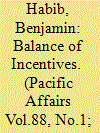

|
|
|
|
|
| Summary/Abstract |
This study is concerned with motivations driving North Korea’s interaction with the United Nations Framework Convention on Climate Change, drawing on information from treaty reporting documents, along with project reports compiled by international agencies and official statements released by the North Korean government. The article draws on causal inference to explore the hypothesis that the leadership perpetuation and state survival imperatives of the North Korean government represent the most likely explanation for North Korea’s interaction with the international climate change regime. It finds a strong probability that North Korea is utilising the UNFCCC as a capacity-building vehicle across its agricultural and energy sectors, a weak issue_images_88_1_Hydroelectric dam at Sinpyong (July 2012)_Habibpossibility that North Korea’s climate change vulnerability is a compelling incentive for greenhouse gas mitigation, and the weak possibility that North Korea is using the Clean Development Mechanism under the UNFCCC as a means for generating foreign currency revenue. The paper argues that the balance of incentives underpinning these motivations can be linked to the leadership perpetuation and state survival imperatives of the North Korean government.
|
|
|
|
|
|
|
|
|
|
|
|
|
|
|
|
| 4 |
ID:
133215
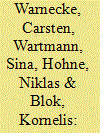

|
|
|
|
|
| Publication |
2014.
|
| Summary/Abstract |
The current project-based carbon market mechanisms such as the Clean Development Mechanism (CDM) and the Joint Implementation (JI) do not have a direct impact on global greenhouse gas emission levels, because they only replace or offset emissions. Nor do they contribute to host country×s national greenhouse gas emission reduction targets. Contributions to net emission reductions in host countries is likely to become mandatory in new mechanisms under development such as in the framework for various approaches, a new market-based mechanism and even in a reformed JI. This research analysed the question if approaches for carbon market-based mechanisms exist that allow the generation of net emission reductions in host countries while keeping project initiation attractive. We present a criteria-based assessment method and apply it for four generic options in existing mechanisms and derive implications for future mechanism frameworks. We identified the application of "discounts" on the amount of avoided emissions for the issuance of carbon credits and "standardisation below business as usual" as most promising options over "limiting the crediting period" and "over-conservativeness". We propose to apply these options differentiated over project types based on internal rate of return to ensure cost-efficiency and attractiveness.
|
|
|
|
|
|
|
|
|
|
|
|
|
|
|
|
| 5 |
ID:
111064


|
|
|
|
|
| Publication |
2012.
|
| Summary/Abstract |
The carbon market experiences of Brazil and India represent policy success stories under several criteria. A careful evaluation, however, reveals challenges to market development that should be addressed in order to make the rollout of a post-2012 CDM more effective. We conducted firm-level interviews covering 82 CDM plants in the sugar and cement sectors in Brazil and India, focusing on how individual managers understood the potential benefits and risks of undertaking clean development mechanism (CDM) investments. Our results indicate that the CDM operates in a far more complex way in practice than that of simply adding a marginal increment to a project's internal rate of return. Our results indicate the following: first, although anticipated revenue played a central role in most managers' decisions to pursue CDM investments, there was no standard practice to account for financial benefits of CDM investments; second, some managers identified non-financial reputational factors as their primary motivation for pursuing CDM projects; and third, under fluctuating regulatory regimes with real immediate costs and uncertain CDM revenue, managers favored projects that often did not require carbon revenue to be viable. The post-2012 CDM architecture can benefit from incorporating these insights, and in particular reassess goals for strict additionality and mechanisms for achieving it.
|
|
|
|
|
|
|
|
|
|
|
|
|
|
|
|
| 6 |
ID:
109663
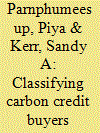

|
|
|
|
|
| Publication |
2011.
|
| Summary/Abstract |
Carbon markets are increasingly conscious of the social and environmental 'quality' of credits delivered by CDM projects. Consequently carbon credits are no longer viewed as a homogenous good and buyers now differentiate between credits supplied by different types of CDM project. The objective of this paper is to classify CER buyers according to their attitudes towards and preferences for CDM sustainability labels. K-means clustering was used to segment a sample of buyers into two clusters. The results indicate that two clear clusters exist with distinct profile patterns. Moreover, the results of discriminant analysis confirmed that the two-cluster solution was valid. Finally, the results of the chi-square analysis and a cross-tabulation showed that these two clusters were significantly different in: organization type; level of paid up capital; perception of sustainable development benefits; perception of return on investment; perception of image of the sustainability labeling; participation in the voluntary market; the project priority; knowledge in the sustainability label; attitude towards the host country's duty; and their willingness to pay.
|
|
|
|
|
|
|
|
|
|
|
|
|
|
|
|
| 7 |
ID:
095941
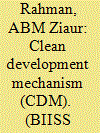

|
|
|
| 8 |
ID:
118109
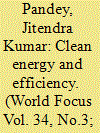

|
|
|
| 9 |
ID:
122734
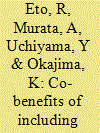

|
|
|
|
|
| Publication |
2013.
|
| Summary/Abstract |
This study examines the effects of the inclusion of the co-benefits on the potential installed capacity of carbon dioxide capture and storage (CCS) projects with a linear programming model by the clean development mechanism (CDM) in India's power sector. It is investigated how different marginal damage costs of air pollutants affect the potential installed capacity of CCS projects in the CDM with a scenario analysis. Three results are found from this analysis. First, large quantity of IGCC with CCS becomes realizable when the certified emission reduction (CER) prices are above US$56/tCO2 in the integrated Northern, Eastern, Western, and North-Eastern regional grids (NEWNE) and above US $49/tCO2 in the Southern grid. Second, including co-benefits contributes to decrease CO2 emissions and air pollutants with introduction of IGCC with CCS in the CDM at lower CER prices. Third, the effects of the co-benefits are limited in the case of CCS because CCS reduces larger amount of CO2 emissions than that of air pollutants. Total marginal damage costs of air pollutants of US$250/t and US$200/t lead to CER prices of US$1/tCO2 reduction in the NEWNE grid and the Southern grid.
|
|
|
|
|
|
|
|
|
|
|
|
|
|
|
|
| 10 |
ID:
093527


|
|
|
|
|
| Publication |
2010.
|
| Summary/Abstract |
The existing literature generally ascribes the virtual absence of the transport sector from the Clean Development Mechanism (CDM) to the inherent complexity of quantifying emission reductions from mobile sources. We use archival analysis and interviews with CDM decision-makers and experts to identify two additional groups of explanations. First, we show the significance of aspects of the CDM's historical evolution, such as the order in which methodologies were considered and the assignment of expert desk reviewers. Second, we highlight inconsistencies in the treatment of uncertainty across sectors. In contrast to transport methodologies, other sectors are characterized by a narrow focus on sources of measurement uncertainty and a neglect of economic effects ("market leakages"). We do not argue that the rejection of transport methodologies was unjustified, but rather than many of the same problems are inherent in other sectors. Thus, the case of transport sheds light on fundamental problems in quantifying emission reductions under the CDM. We argue that a key theoretical attraction of the CDM-equalization of marginal abatement costs across all sectors-has been difficult to achieve in practice.
|
|
|
|
|
|
|
|
|
|
|
|
|
|
|
|
| 11 |
ID:
103379
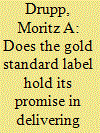

|
|
|
|
|
| Publication |
2011.
|
| Summary/Abstract |
The Clean Development Mechanism (CDM) has a twin objective: to help developed countries reduce GHG emissions, and to support developing countries in achieving Sustainable Development (SD). As a response to the widespread criticism of the CDM's unsatisfactory SD record, initiatives have developed premium labels like the Gold Standard, which applies two additional 'screens' to filter CDM projects for higher SD benefits. In order to determine whether Gold Standard projects can be associated with higher local SD benefits, this paper evaluates the potential benefits of 48 CDM projects using a multi-criteria method and building on existing work. The 18 evaluated Gold Standard projects are compared to a 'representative portfolio' of 30 unlabeled CDM projects in order to capture the 'full' effect of the additional Gold Standard requirements, which is further decomposed into the two 'screen' effects. The results suggest that Gold Standard Certified Emission Reductions can be associated with higher potential local SD benefits when compared to the 'representative portfolio' of unlabeled CDM projects, while the comparison of projects of the same type remains inconclusive. The results support previous findings showing that renewable energy projects may deliver comparatively high SD benefits.
|
|
|
|
|
|
|
|
|
|
|
|
|
|
|
|
| 12 |
ID:
093507
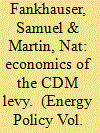

|
|
|
|
|
| Publication |
2010.
|
| Summary/Abstract |
A levy on the Clean Development Mechanism and other carbon trading schemes is a potential source of finance for climate change adaptation. An adaptation levy of 2% is currently imposed on all CDM transactions which could raise around $500 million between now and 2012. This paper analyses the scope for raising further adaptation finance from the CDM, the economic costs (deadweight loss) of such a measure and the incidence of the levy, that is, the economic burden the levy would impose on the buyers and sellers of credits. We find that a levy of 2% could raise up to $2 billion a year in 2020 if there are no restrictions on demand. This could rise to $10 billion for a 10% tax. Restrictions on credit demand (called supplementarity limits, the requirement that most emission abatement should happen domestically) curtail trade volumes and consequently tax revenues. They also alter the economic impact of the CDM levy. Without supplementarity restrictions sellers (developing countries) bear two-thirds of the cost of the tax. If there are supplementarity limits they can pass on the tax burden to buyers (developed countries) more or less in full. Without supplementarity restrictions the distortionary effect of the levy (its deadweight loss) rises sharply with the tax rate. With them the deadweight loss is close to zero.
|
|
|
|
|
|
|
|
|
|
|
|
|
|
|
|
| 13 |
ID:
094941


|
|
|
|
|
| Publication |
2010.
|
| Summary/Abstract |
The majority of the Middle East and North Africa (MENA) countries possess substantial potential for the implementation of CDM projects. Abatement of Greenhouse Gas (GHG) emissions can mainly be achieved through utilizing the abundant Renewable Energy Sources (RES) in the region and the implementation of Energy Efficiency (ENEF) measures. However, most of the MENA countries have a limited track record as regards CDM projects in the pipeline comparing to the major CDM-players, like Asia-Pacific regions and Latin America. In the above framework, this paper investigates the current status of CDM in the MENA region and the related perspectives for further diffusion of the CDM though the elaboration of a Strengths-Weaknesses-Opportunities and Threats (SWOT) Analysis. Particular emphasis is laid on the case of Israel, which seems to make an exception to the rule, since it hosts most projects in the region and dominates among the MENA countries.
|
|
|
|
|
|
|
|
|
|
|
|
|
|
|
|
| 14 |
ID:
096113
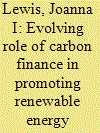

|
|
|
|
|
| Publication |
2010.
|
| Summary/Abstract |
The world is negotiating what the international climate change regime will look like after 2012-the year that current Kyoto Protocol greenhouse gas emissions reduction targets expire-and the future of the Clean Development Mechanism (CDM) is under discussion. Critics claim the scale of reductions that the CDM is driving in the developing world is insufficient from a scientific perspective if we are to avoid dangerous climate change, that the project-by-project crediting process is inefficient, and that the reductions being achieved are not "additional"-meaning they would have happened anyway and thus should not be financially supported. Yet, the efficacy of CDM must be examined in the broader context of carbon mitigation in the developing world and the actions that are taking place. This paper examines the role that the CDM has played in promoting renewable energy development in China in order to assess how international carbon finance can best be used to help promote emissions mitigation in the developing world. It also assesses how several options under consideration for reforming the current structure of the CDM in particular and developing country engagement in general may impact renewable energy development in China in the coming years.
|
|
|
|
|
|
|
|
|
|
|
|
|
|
|
|
| 15 |
ID:
092578
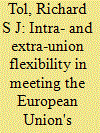

|
|
|
|
|
| Publication |
2009.
|
| Summary/Abstract |
The EU has proposed four flexibility mechanisms for the regulation of greenhouse gas emissions in the period 2013-2020: (1) the Emissions Trade Scheme (ETS), a permit market between selected companies; (2) trade in non-ETS allotments between Member States; (3) the Clean Development Mechanism (CDM) to purchase offsets in developing countries; and (4) trade in CDM warrants between Member States. This paper shows that aggregate abatement costs fall as flexibility increases. However, limited flexibility creates rents so that increasing flexibility raises costs in some Member States. Costs are reduced more by the CDM than by non-ETS trade. The CDM warrants market reduces costs by a small amount only; market power is a real issue. However, the warrants market is obsolete in case there is non-ETS trade. The CDM leads to price convergence between the ETS and non-ETS market. There would be one price for carbon in the European Union if the proposed limits on CDM access are relaxed slightly.
|
|
|
|
|
|
|
|
|
|
|
|
|
|
|
|
| 16 |
ID:
098571
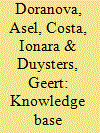

|
|
|
|
|
| Publication |
2010.
|
| Summary/Abstract |
The Clean Development Mechanism (CDM) is one of the three greenhouse gas emission reduction and trading instruments of the Kyoto Protocol (KP). The CDM allows governments and business entities from developed countries to offset their emissions liabilities by reducing or avoiding emissions in developing countries, where it is often cheaper to do so. Our results reveal that the majority of the CDM projects utilise local sources of technology. We attempt to explain technology sourcing patterns in CDM projects through the use of knowledge based determinants. Our empirical analysis indicates that in countries with a stronger knowledge base in climate friendly technologies, CDM project implementers tend to use local, as well as a combination of local and foreign technologies, more than foreign technologies.
|
|
|
|
|
|
|
|
|
|
|
|
|
|
|
|
| 17 |
ID:
088029
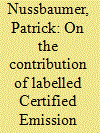

|
|
|
|
|
| Publication |
2009.
|
| Summary/Abstract |
The Clean Development Mechanism (CDM) has a twofold objective, to offset greenhouse gas emissions and to contribute to sustainable development in the host country. The contribution to the latter objective seems marginal in most CDM activities. Also, CDM activities are unevenly spread among developing countries. In response to these concerns, initiatives with the objective of promoting CDM projects with broad local sustainable development dividends have been launched, such as the Gold Standard and the Community Development Carbon Fund. The Gold Standard label rewards best-practice CDM projects while the Community Development Carbon Fund focuses on promoting CDM activities in underprivileged communities. Using a multi-criteria method, the potential contribution to local sustainable development of those CDM projects with particular attributes is compared with ordinary ones. This evaluation suggests that labelled CDM activities tend to slightly outperform comparable projects, although not unequivocally.
|
|
|
|
|
|
|
|
|
|
|
|
|
|
|
|
| 18 |
ID:
142662
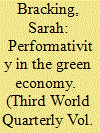

|
|
|
|
|
| Summary/Abstract |
This paper asks how far performativity in the Green Economy generates material or virtual assets. It examines the relationship between assets and their financial derivatives, asking how far the value of ‘carbon’ or ‘green’ can be directly attributed to its social and narrative construction. The paper draws on two case studies – one of the Clean Development Mechanism (CDM) in South Africa, the other of the global private green bonds market – to show that both public and private climate finance can generate virtual economic activity co-produced by processes of social valuation and accumulation proper. How reliant is the Green Economy on actual economic activity?
|
|
|
|
|
|
|
|
|
|
|
|
|
|
|
|
| 19 |
ID:
096744
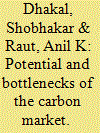

|
|
|
|
|
| Publication |
2010.
|
| Summary/Abstract |
The majority of clean development mechanism (CDM) projects are confined to a few countries. For many developing nations, entry into the carbon market, either through CDM or others, has been difficult. Thus, rationalizing CDM projects and the carbon market as a tool for sustainable development is often questioned. Many developing countries, such as Nepal, lack a quantification of CO2 reduction potential and an assessment of bottlenecks necessary for the carbon market. In this context, this paper assesses the potential emission reductions from major sectors of Nepal and the accompanying bottlenecks of the carbon market. The analyses provide indications of the type and scale of the carbon mitigation opportunities in key sectors such as waste management, biogas utilization, promotion of electric vehicles, rice cultivation, bio-energy utilization, brick making, hydropower development and a few others. These might be helpful to decision-makers in Nepal as well as to the process of re-orienting CDM and other carbon markets to better understand the bottlenecks of developing countries.
|
|
|
|
|
|
|
|
|
|
|
|
|
|
|
|
| 20 |
ID:
097599
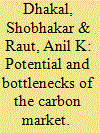

|
|
|
|
|
| Publication |
2010.
|
| Summary/Abstract |
The majority of clean development mechanism (CDM) projects are confined to a few countries. For many developing nations, entry into the carbon market, either through CDM or others, has been difficult. Thus, rationalizing CDM projects and the carbon market as a tool for sustainable development is often questioned. Many developing countries, such as Nepal, lack a quantification of CO2 reduction potential and an assessment of bottlenecks necessary for the carbon market. In this context, this paper assesses the potential emission reductions from major sectors of Nepal and the accompanying bottlenecks of the carbon market. The analyses provide indications of the type and scale of the carbon mitigation opportunities in key sectors such as waste management, biogas utilization, promotion of electric vehicles, rice cultivation, bio-energy utilization, brick making, hydropower development and a few others. These might be helpful to decision-makers in Nepal as well as to the process of re-orienting CDM and other carbon markets to better understand the bottlenecks of developing countries.
|
|
|
|
|
|
|
|
|
|
|
|
|
|
|
|
|
|
|
|
|